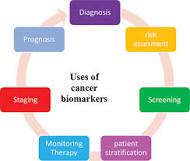Joseph R. Anticaglia MD
Medical Advisory Board
“I choose not to keep my story private, because there are many women who do not know that they might be living under the shadow of cancer. It is my hope that they, too, will be able to get gene tested, and that if they have a high risk they, too, will know that they have strong options,” said Jolie.

Cancer happens when some of the body’s cells grow uncontrollably, and spreads to different parts of the body. Scientists have been struuggling for decades to come up with effective ways to prevent, diagnose, monitor, and treat this disease. Clinicians use biomarkers as instruments to better manage their cancer patients. What are biomarkers in cancer?
Tumor Biomarkers are proteins, genes, or other substances presentt in cancer cells. In addition, biomarkers can be substances produced by the cancer cells, or by the cells in the body in response to to a specific cancer. These biological molecules, tumor markers, can provide informaation about the characteristics of the tumor that guide decisions concerning the care of patients.
How are biomarkers used in cancer care?
There are two main types of tumor markers: circulating tumor markers, and tumor tissue markers according to the National Cancer Institute:
Circulating tumor markers can be found in the blood, urine, stool, or other bodily fluids of some patients with cancer.
Tumor tissue (or cell) markers are found in the actual tumors themselves, typically in a sample of the tumor that is removed during a biopsy
Both circulating and tissue markers help to determine the stage of the cancer, estimate the prognosis, and consider treatment options.
Circulating tumor markers, in addition, monitor whether the treatment is working, detect if cancer has returned after treatment, or if there is residual disease (cancer that remains after treatment). Another perspective is to view biomarkers through the lens of oncologists.
Cancer specialists (Oncologists) look at biomarkers as a tool to:
- provide information about the risk to develop cancer
- diagnose what type of cancer it is
- as a tool to develop treatment plans once the cancer has been diagnosed
- determine the prognosis, the outcome, of patients according to the type of their cancer
- predict how some patients might respond to medications.
- as a tool to classify a tumor using the TNM staging system (see glossary) which provides a basis for predicting a patient’s survival, treatment decisions, and stratification of patients
- to stratify or divide patients in clinical trials into distinct subgroups — patient stratification
- as a tool to monitor, and modify the drug dose to improve effectiveness, and/or reduce toxicity. Has the treatment stopped working?

What Is the BRCA Gene Test?
It is a blood test that uses DNA analysis to identify mutations, harmful changes, in two breast cancer genes, BRCA1 and BRCA2. A positive finding, as in the case of Jolie, places a woman at an increased risk of developing breast cancer, and ovarian cancer.
Angelina Jolie and Her Prophylactic (Disease Preventing) Surgery
At the age of 37, in February of 2013, Ms. Jollie underwent a bilateral, prophylactic mastectomy after learning she had an 87 percent risk of developing breast cancer due to a defective BRCA1 gene. Her maternal, ancestral tree is notable with a strong family history of cancer.
- Her mother had breast cancer and died of ovarian cancer.
- Her grandmother died of ovarian cancer.
- Her aunt, who had the same BRCA1 defect, died of breast cancer three months after Jolie’s operation.
In March 2015, after annual test results indicated she was at an increased risk of developing ovarian cancer, Ms. Jolie underwent prophylactic surgery involving the bilateral removal of the ovaries and fallopian tubes (bilateral salpingo-oophorectomy). She has become an advocate encouraging women to seek medical advice to reduce the incidence of breast and ovarian cancer.
Biomarker testing in cancer has become an increasingly important tool in cancer diagnosis, treatment, prognosis, and monitoring of the disease. It is a rapidly evolving field in cancer research, with new biomarkers being discovered and validated regularly with the goal of improving patient care. Jolie’s public announcement concerning her surgeries, “I choose not to keep my story private,” has led to greater awareness of gene testing, and better health care for women.
References
- C N A M Oldenhuis et al; Prognostic versus predictive value of biomarkers in oncology; Eur J Cancer; May,2008
- Joseph A Ludwig, and John N. Weinstein; Biomarkers in Cancer Staging and Treatment Selection; Nature Reviews, 2005
- H. F. M. Kamel, A. Alamodi; Clinical utility and uses of cancer biomarkers; Cancer Biomarkers, 2016
- MD Anderson Center; How Are Biomarkers Used To Treat Cancer; April 5, 2021National
- National Cancer Institute; Tumor markers in Common Use; May 11, 2021
- National Cancer Institue Tumor Maarkers, May 11, 2021
- Joseph R. Anticaglia, MD; Biomarkers in Medicine Essential Medical Tools; Doctors Columnm HC Smart, 2023
- Jolie, Angelina; “My Medical Choice”. May 14, 2013, The New York Times.
- Angelina Jolie; Wikipedia
- Angelina Jolie Photo, U. S. Department of State, Public domain
Glossary
The TNM staging sysytem is based on a combination of tumor size or depth(T), lymph node spread (N), and the presence of lymph node metatases (M).
BRCA is an abbreviation for breast cancer gene.
Cost: The cost of biomarker testing varies greatly. Be informed.
This article is intended solely as a learning experience. Please consult your physician for diagnostic and treatment options.

